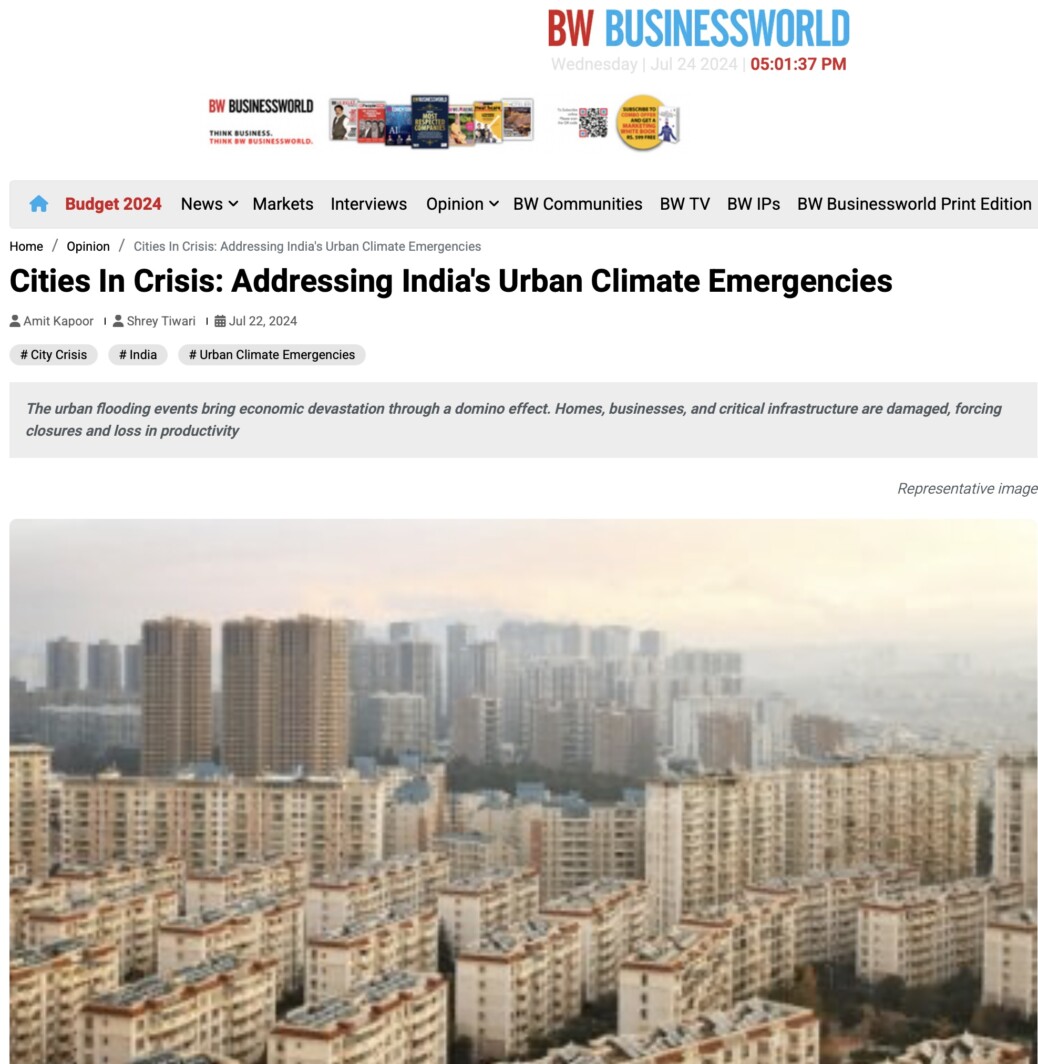By Amit Kapoor and Shrey Tiwari
The country’s metropolitan areas witnessed a triple crisis in June and the wider summer season. The sweltering Indian summer has so far seen the highest number of heatwave days across the country, with June witnessing the warmest temperatures in recorded history. The circumstances were aggravated by a water crisis due to major reservoirs failing to meet the demand of a growing population. Simultaneously, the northeastern part of the country was battling floods due to continuous heavy downpours triggered by the cyclone Remal. The National Capital Region followed suit with the highest single-day rainfall recorded in June, leading to multiple cases of waterlogging across the region. The role of urban infrastructure in adapting and contributing to such disasters is highlighted in the aftermath of these extreme weather events, with significant losses to lives and property at large.
These Indian (mega)cities are experiencing synchronous blows of water shortages and escalating climatic problems due to the country’s rapid and uncontrolled development. The ballooning residential skyscrapers, many of which remain vacant, devour land in the absence of rainwater harvesting equipment. This is causing a dangerous depletion of water sources, especially in conjunction with the widespread extraction of groundwater. Seasons of unpredictable rainfall exacerbate the situation, leaving communities dry and scrambling for drinking water.
The matters are worsened by a complete disregard for natural drainage systems in city planning. There is no room left for rainwater to enter rivers or replenish the earth due to the encroachment on wetlands and the concretization of drains. This is what turns heavy rainfall into deadly catastrophes, as the floods in Delhi this past year have shown. Moreover, the loss of green spaces and the growth of concrete jungles only serve to exacerbate the stress on the environment. This urban sprawl is also leading to a rise in the number of “Heat Islands”. Contributing to this situation are the rising air pollution levels and energy usage, with the latter still largely dependent on fossil fuels. According to research by IIT-Bhubaneswar, urbanization is responsible for an astounding 60% of the increase in temperature in Indian cities.
The urban flooding events bring economic devastation through a domino effect. Homes, businesses, and critical infrastructure are damaged, forcing closures and loss in productivity. Transportation grinds to a halt as gridlocked roads and the stoppage of public transport hinder the movement of goods and services. As per the State of Climate in Asia report, damages relating to floods and storm cost the Indian economy around $7.6 billion in 2020-21 alone. The state of infrastructure in the country, along with other low- and middle-income countries (LMIC) underscores the extent of damage during such extreme events. The Intergovernmental Panel on Climate Change (IPCC) claims that the countries in South Asia and Africa bear the highest losses due to unreliable infrastructure. The direct losses to firms operating in the LMIC due to transportation disruptions amount to $107 bn a year. On the other hand, the direct losses resulting from disruptions to water supply are expected to be around $6 bn for the firms and $88-$153 bn to the households.
The rising average temperatures, and resultant heatwaves, are also proving detrimental to India in terms of lives lost, crop failures, and decreased productivity. The countries in the Global South are witnessing a loss of up to 6.7% of the GDP per capita per year, significantly higher than the 1.5% losses in the high-income countries. The International Labour Organization warned that working in moderately physical jobs in temperatures above 33-34°C could lead to as much as 50% loss in individual productivity. As per the Climate Transparency Report, the potential income losses due to this reduced capacity among workers in India was estimated to be $159 bn, over 5% of the GDP in 2021. If the average temperatures in the country keep on increasing, the production of important crops such as rice and maize could also drop 10-30% and 25-70% respectively.
India’s booming cities face a huge influx of people, with about 400 million additional people in the urbanization fold by 2050. While disaster plans exist for heatwaves and floods, the focus is on reaction, not prevention. Sustainable practices like rainwater harvesting and cool roofing are rarely enforced, despite mandates. This lack of long-term planning strains resources and the unprepared infrastructure highlights the need for a multi-pronged approach to sustainable urban development.
India’s national urban programs such as Atal Mission for Rejuvenation and Urban Transformation (AMRUT), and Smart Cities Mission address climate change, but individual cities need unique solutions. For instance, poor maintenance of the existing infrastructure in the form of jammed floodgates was touted as one of the many reasons for Delhi’s disastrous floods last year. Hence, more funding is needed for sustainable construction practices and upgrades to existing infrastructure, including improved drainage and green spaces. Around the world, cities like New York, Shanghai, and Cardiff have invested heavily towards their transformation as ‘sponge cities’ allowing for absorption and storage of rainwater, reducing urban flooding. This was achieved by improving drainage systems and increasing green spaces through inner-city gardens, among other conventional initiatives adapting to the local needs.
Moreover, public participation is crucial to maximize the impact of climate-friendly initiatives. Local communities need to embrace sustainable practices alongside improved infrastructure. With the increased instances of climate catastrophes the world over, it is imperative to initiate and sustain mass local-level movements to prepare our cities for such instances. The 11 lives lost in Delhi’s deluge, and the 50-plus deaths in heatwaves across the country so far this year are a somber reminder of the stakes involved in climate catastrophes plaguing our cities. Making our cities climate-resilient will thus have far-reaching consequences in securing the lives and livelihoods of the masses.
The article was published with Business World on July 22, 2024.
























